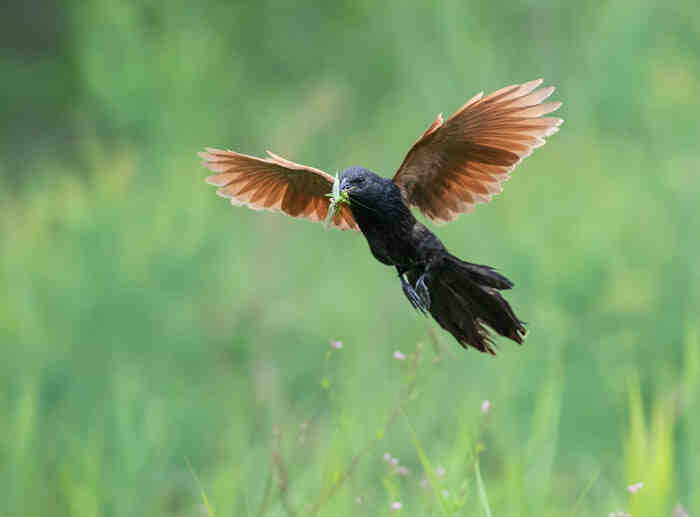Centropus bengalensis
IUCN
LCBasic Information
Scientific classification
- name:Centropus bengalensis
- Scientific Name:Centropus bengalensis,Lesser Coucal,Little Chicken,Little Crow Pheasant,Little Pheasant Cock,Little Wasp
- Outline:Climbing birds
- Family:Cuculiformes Ericidae Cuckoo
Vital signs
- length:30-39.8cm
- Weight:85-167g
- lifetime:About 10-20 years
Feature
It looks similar to the brown-winged cuckoo, but is smaller in size and has reddish-brown or chestnut underwing feathers.
Distribution and Habitat
World distribution: Bangladesh, Bhutan, Brunei, Cambodia, China, India, Indonesia, Laos, Malaysia, Myanmar, Nepal, Philippines, Singapore, Thailand, East Timor, Vietnam.
Migrant bird: Sri Lanka.
Distribution in China: Yunnan, Guizhou, Guangxi, Guangdong, Hainan, Anhui, Henan, Fujian and Taiwan.
The little cuckoo lives in shrubs, grass, orchards and secondary forests in low mountains and hills and open plains at the foot of Baoshan.
Appearance
The head, neck, upper back and lower body of the little cuckoo are black, with dark blue luster and bright black feathers. The lower back and upper tail coverts are light black with a blue luster; the tail is black with a green metallic luster and a narrow white tip; the shoulders, inner side of the shoulders and both wings are maroon, and the wing tips and inner secondary flight feathers are darker brown, revealing Light chestnut trunk.
The head, neck and upper back of the young cuckoo are dark brown, with white feather stems and brown feather edges; the coverts from the waist to the tail are alternately brown and black horizontal spots, and the tail is light black with brown end spots. The central tail feathers have brown-white horizontal spots and brown end spots. The lower body is light brown and white, the feather shaft is white, the chest and two flanks are dark, and the two flanks have dark brown horizontal spots. The wings are maroon, and the underwing coverts are light maro
Details
Lesser Coucal is a medium-sized bird with three subspecies.

Lesser Coucal is a resident bird, often moving alone or in pairs. It is smart and secretive, and will immediately run into dense bushes or grass if it is slightly disturbed. It mainly feeds on insects and other small animals such as locusts, mole crickets, beetles, stink bugs, termites, mantises, lice, etc., and also eats a small amount of plant fruits and seeds. The call is a few deep and hollow "hoop" sounds, the speed increases and the pitch decreases. The second call is a series of "kroop-kroop-kroop" sounds.
The breeding season of the small cuckoo is from March to August. It nests in dense bushes, dwarf bamboo bushes and other plants. The nest is mainly made of calamus, miscanthus and other dry grasses, and is spherical or oval in shape. It is usually placed on the branches of bushes or small trees, about 1m above the ground. Each nest lays 3-5 eggs, which are oval, white and spotless, and are 25-34 mm × 21-25 mm in size.
The distribution range of the little cuckoo is wide, and it is not close to the critical value of vulnerable and endangered species survival (distribution area or fluctuation range is less than 20,000km², habitat quality, population size, and fragmented distribution area). The population trend is increasing, so it is evaluated as a species of least concern.
Listed in the 2012 Red List of Endangered Species of the World Conservation Union (IUCN) ver 3.1-Least Concern (LC).
Listed in the second level of the "List of National Key Protected Wildlife in China".
Protect wild animals and stop eating game.
Maintaining ecological balance is everyone's responsibility!








